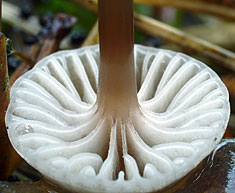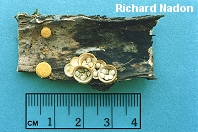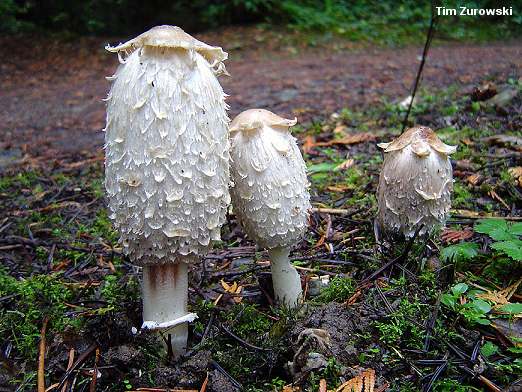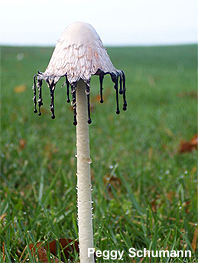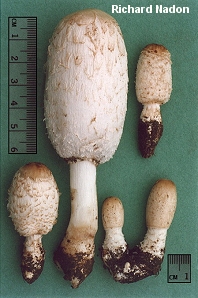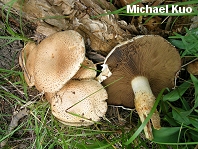.jpg) |
| Fig. 1 Eyelash Cup Fungus showing the miniscule hairs along the exterior and margin of the fungus (Stevens & Woods, 2009). |
Name: Scutellinia scutellata -Eyelash Pixie Cup
Family: PyronemataceaeCollection Date: November 8, 2011
Habitat: Growing on wood
Location: Hiram Field Station
Description: "At first spherical, but soon opens to form a shallow cup and eventually a disklike (flattened). Fertile (upper) surface smooth, bright red to scarlet to orange (or rarely paler with a pinkish cast); margin conspiciously ciliate (fringed with dark brown or blackish hairs up to 1 mm long). Exterior (underside) also clothed with dark hairs. Flesh very thin. Stalk absent. Found growing on rotten wood or damp soil ( or occasionally on ashes, wet leaves, or conks); widely distributed and common, but easily overlooked because of its small size" (Aurora, 1986).
"Spores... smooth when immature, and remaining so for a long time--but in maturity prominently sculpted with warts and ribs extending to about 1 µ high; with several oil droplets. Paraphyses with swollen tips 6-10 µ across" (Kuo, 2009).
Collector: Brooke WarrenKey Used: Aurora, D. (1986). Mushrooms Demystified. New York: Ten Speed Press.
Keying Steps:
Key to the Major Groups of Fleshy Fungi p. 52
1B. Spores produced inside mother cells called asci; fruiting body variously shaped (see pg. 55).... Ascomycotina, p. 782
Key to the Ascomycetes p. 782
1B. Not as above; growing on wood or on ground, on insects, other mushrooms, plants, etc... 2
2A. Growing on wood (but wood sometimes buried)... 3
3B. Fruiting body cuplike or variously shaped but not as above, or if colored as above then texture usually different (fragile, fleshy, rubbery, gelatinous, etc.); asci typically borne in a palisade (hymenium), not in perithecia... Discomycetes, p. 783
Key to Discomycetes
1B. Not as above; fruiting body occasionally buried but usually above the ground at muturity or on wood, moss, etc.; spore-bearing surface exposed (external) at maturity... 2
2A. Fruiting body cup- to ear-shaped, disklike (flat), cushion-like, top-shaped, or sometimes contorted; stalk absent or present only as a narrowed base (but fruiting body sometimes growing erect like a rabbit's ear); asci operculate (i.e., with "lid" at tip)... Pezizales p.783
Key to Pezizales
1B. Not as above... 3
3A. Fruiting body cup-shaped (concave) to disk-like (flat), cushion-shaped, or sometimes top-shaped or splitting into rays; stalk present or absent; flesh gelatinous, fragile, or tough... 4
4A. Stalk absent, or if present then often (but not always) short or merely a narrowed, downward extension of the cup; stalk when present usually lacking distinct ribs; fruiting body fleshy, fragile, rubbery, or gelatinous, sometimes brightly colored, large to minute; tips of asci amyloid or not amyloid.... Pezizacea & Allies, p. 817
Key to the Pezizacea & Allies
1B. Not as above... 2
2B. Not with above features (but may have some of them)... 3
3B. Not as above... 4
4B. Not as above; fruiting body cuplike, earlike, disclike, etc. (but sometimes contorted, especially if growing in clusters)... 6
6B. Not as above; fruiting bodies sometims slit down one side but not consistently so, and not usually growing erect; sometimes growing on dung... 7
7A. Fertile (upper or inner) surface of fruiting body brightly colored (red, orange, yellow, blue, or green, but not violet)... Aleuria & Allies, p. 833
Key to Aleuria & Allies
1B. Not as above... 3
3A. Exterior (underside) of cup or disc clothed with brown to black hairs; margin often fringed with dark hairs also... 4
4B. Not as above... 5
5A. Fertile (upper) surface yellow, orange, or red... 6
6B. Not as above; growing in soil, humus, or on wood but not usually in burned areas... 7
7B. Not as above... 8
8B. Underside of fruiting body with fairly obvious hairs which fringe the margin like eyelashes; fertile surface bright red to orange-red or orange... Scutellina scutellata & others, p. 839
Additional References:
Kuo, M. (2009, April). The eyelash cup: Scutellinia scutellata. Retrieved from the MushroomExpert.Com Web site: http://www.mushroomexpert.com/scutellinia_scutellata.html
Stevens, F. & Woods, M. (2009). California Fungi- Scutellina scutella. The Fungi of California. http://www.mykoweb.com/CAF/species/Scutellinia_scutellata.html
Wolf, R. (2011). Scutellinia scutellata. Calphotos. http://calphotos.berkeley.edu/cgi/img_query?stat=BROWSE&query_src=photos_fungi_com&where-genre=Fungi&where-namesoup=Eyelash+Pixie+Cup&rel-namesoup=matchphrase&title_tag=Eyelash+Pixie+Cup
Links:
http://www.mushroomexpert.com/scutellinia_scutellata.html
http://www.mykoweb.com/CAF/species/Scutellinia_scutellata.html
Key to Pezizales
1B. Not as above... 3
3A. Fruiting body cup-shaped (concave) to disk-like (flat), cushion-shaped, or sometimes top-shaped or splitting into rays; stalk present or absent; flesh gelatinous, fragile, or tough... 4
4A. Stalk absent, or if present then often (but not always) short or merely a narrowed, downward extension of the cup; stalk when present usually lacking distinct ribs; fruiting body fleshy, fragile, rubbery, or gelatinous, sometimes brightly colored, large to minute; tips of asci amyloid or not amyloid.... Pezizacea & Allies, p. 817
Key to the Pezizacea & Allies
1B. Not as above... 2
2B. Not with above features (but may have some of them)... 3
3B. Not as above... 4
4B. Not as above; fruiting body cuplike, earlike, disclike, etc. (but sometimes contorted, especially if growing in clusters)... 6
6B. Not as above; fruiting bodies sometims slit down one side but not consistently so, and not usually growing erect; sometimes growing on dung... 7
7A. Fertile (upper or inner) surface of fruiting body brightly colored (red, orange, yellow, blue, or green, but not violet)... Aleuria & Allies, p. 833
Key to Aleuria & Allies
1B. Not as above... 3
3A. Exterior (underside) of cup or disc clothed with brown to black hairs; margin often fringed with dark hairs also... 4
4B. Not as above... 5
5A. Fertile (upper) surface yellow, orange, or red... 6
6B. Not as above; growing in soil, humus, or on wood but not usually in burned areas... 7
7B. Not as above... 8
8B. Underside of fruiting body with fairly obvious hairs which fringe the margin like eyelashes; fertile surface bright red to orange-red or orange... Scutellina scutellata & others, p. 839
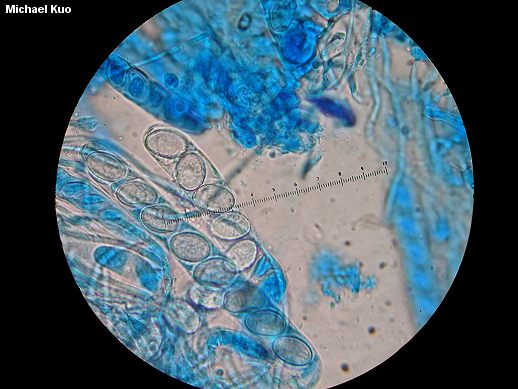 |
| Fig. 2 The spores of this fungus are so small they are unable to be seen with the naked eye. Here a microscope enables us to see what they look like (Kuo, 2009). |
 |
| Fig. 3 Eyelash Cup Fungi again showing the hairs on the exterior and margins of the fungus (Wolf, 2011). |
 |
| Fig. 3 Eyelash Fungi growing on a decaying tree (Brooke Warren). |
Additional References:
Kuo, M. (2009, April). The eyelash cup: Scutellinia scutellata. Retrieved from the MushroomExpert.Com Web site: http://www.mushroomexpert.com/scutellinia_scutellata.html
Stevens, F. & Woods, M. (2009). California Fungi- Scutellina scutella. The Fungi of California. http://www.mykoweb.com/CAF/species/Scutellinia_scutellata.html
Wolf, R. (2011). Scutellinia scutellata. Calphotos. http://calphotos.berkeley.edu/cgi/img_query?stat=BROWSE&query_src=photos_fungi_com&where-genre=Fungi&where-namesoup=Eyelash+Pixie+Cup&rel-namesoup=matchphrase&title_tag=Eyelash+Pixie+Cup
Links:
http://www.mushroomexpert.com/scutellinia_scutellata.html
http://www.mykoweb.com/CAF/species/Scutellinia_scutellata.html
